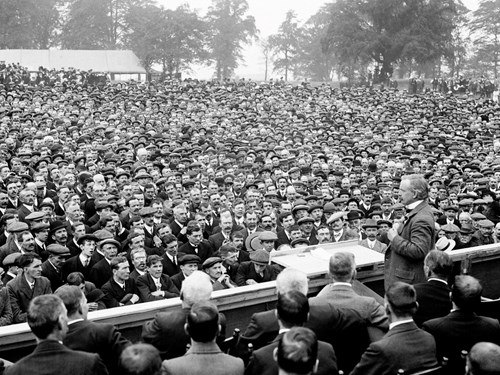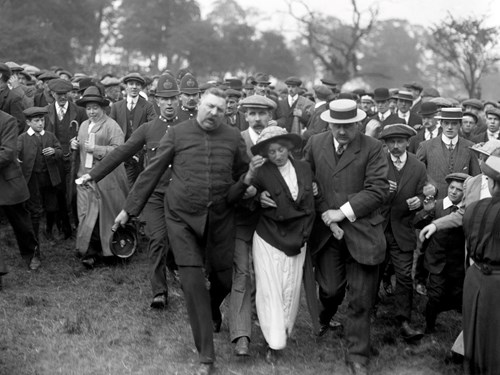Suffragette campaign
1913 was a pivotal year for the Women’s Social and Political Union (WSPU). The country’s monarch was George V, the prime minister was Herbert Henry Asquith, and this was the year suffragette Emily Davison died after running in front of the King’s horse protesting for votes for women. This was also the year when David Lloyd George, then chancellor to Asquith and later prime minister, visited Sutton in Ashfield for a public meeting. David Lloyd George making a speech in Sutton in Ashfield in 1913
David Lloyd George making a speech in Sutton in Ashfield in 1913
In the early part of 1913, attention turned to the Welsh politician when letter bombs were sent to him – as well as the prime minister – as part of the suffragettes’ campaign. They all exploded in places other than their destination, including mailbags, post boxes, and post offices. In February that year, two bombs were planted at Lloyd George’s house at Pinfold Manor, in Surrey. One failed to ignite while the other exploded causing no injuries, but significant damage to the building.
Emmeline Pankhurst was sentenced in April to three years in prison for her role. It was in June that year that Emily Davison ran out in front of the King's horse, Anmer, at Epsom Derby. Suffragette bombing attacks continued in 1913 and in August, a school was bombed and burned down in protest while Lloyd George was visiting Sutton in Ashfield. Lloyd George was prime minister during the latter half of the First World War in 1916 until 1922.  A suffragette is arrested in Sutton in Ashfield in 1913
A suffragette is arrested in Sutton in Ashfield in 1913
The suffragettes paused their campaign when war broke out in 1914 to focus on helping with the war effort. After the war ended, the suffragettes had a significant win in their cause when the Representation of the People Act 1918 gave women over the age of 30 the vote. They did however have to meet certain property qualifications, including being registered property occupiers or married to a registered property occupier of land or premises that had a rateable value greater than £5. A decade later women gained the right to vote at the age of 21 under the Representation of the People (Equal Franchise) Act 1928, under prime minister Stanley Baldwin.
Although it has been a century since the right to vote for women was passed, remembering these moments of protest remain important to understand the journey the Suffragettes went through of civil disobedience and struggle.